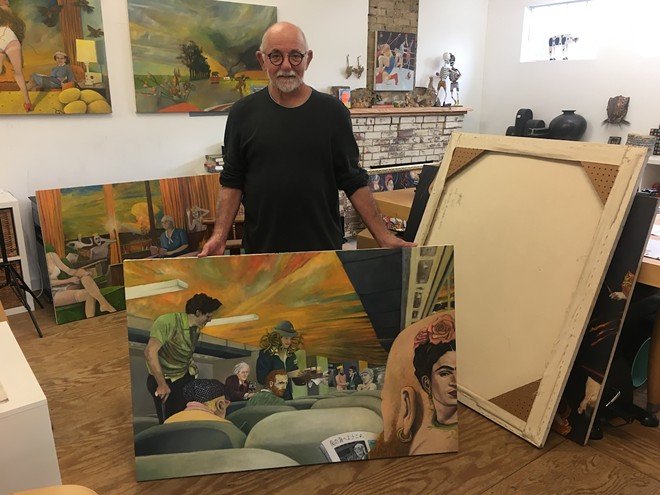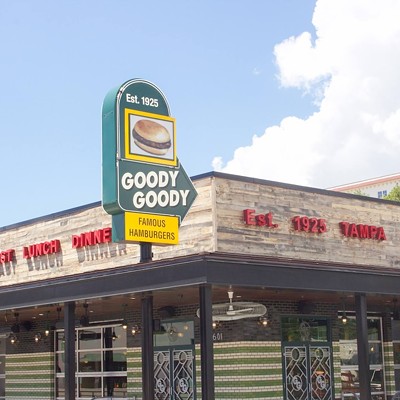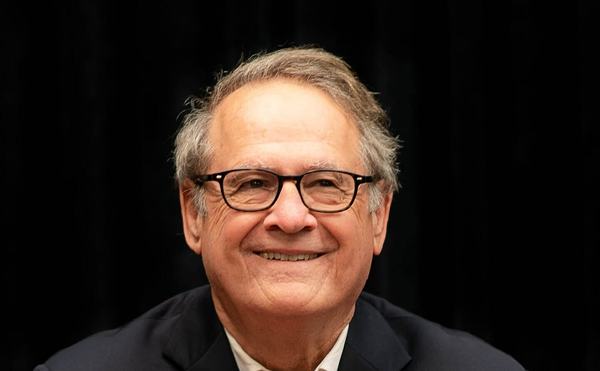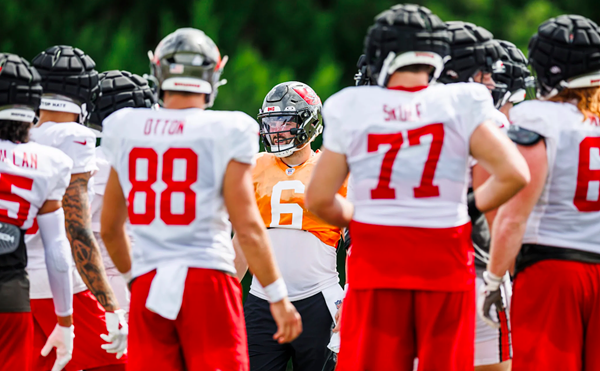"I was looking at the submission emails the other day, and the first one I sent was August of last year,” Sibbitt told Creative Loafing Tampa Bay recently. “A year ago!”
At 71, Sibbitt is basically a patient man, but then he’s needed to be. That email chain eventually included the happy news that several of his latest, large-canvas oil paintings, themselves years in the making, would be included in Skyway 2024, the triennial joint art exhibition featuring the work of top artists from across Tampa Bay.
The Tampa portion of the show opens at the Tampa Museum of Art is open now and runs through January 2025.
It isn’t news that the gears of Art turn slowly—Art is the news that’s supposed to stay new, anyway—but it’s still refreshing and often funny to listen to Sibbitt riff on the contemporary art world and his place in it.
“Everybody talks about your art ‘practice’ now,” he said. “’What’s your practice?’ From what I can tell of the current trends, what’s popular is to cram a lot of different shit into the painting, you know? A lot of information.”
Sibbitt’s paintings do happen to be information-rich—a picture of Amelia Earhart, intricately detailed, appears in the page of a magazine that a character is reading in one of the paintings. And there’s a caption in accurate Japanese lettering above the picture. (“It reads ‘Welcome to the South Seas,’” Sibbitt told me.)
In the same painting, a who’s who of the 19th and 20th century art worlds are in an airplane, with the plane’s ceiling blown off or missing. Where the ceiling should be, in any case, a streaming, red-orange sky unfurls like something out of Revelation. Van Gogh is in an aisle seat, looking back at us with that trademark stare, bold colors, short strokes. And there’s Sibbitt’s beloved Frida Kahlo in the foreground, appearing as a giant tattoo on the head of the man reading the magazine, etc.
Up at the front of the plane is Sibbitt himself, disarmingly naked—and shaking Elvis’s hand.
It takes a minute to take all this in, or it could take all afternoon, and that’s the point. All the different “shit” in the frame makes for a journey of looking.
It’s a journey through art history too, and a take on that history, as Joanna Robotham observed to me. Robotham is a curator at the Tampa Museum of Art and one of several organizers who took on the Herculean task of sifting through the Skyway 2024 entries, from more than 300 artists, and from out of that pool selecting a show.
“With David’s work, there’s this element of irony and wit, and humor,” said Robotham, “but it’s coupled with an unexpected dark side. He always has these turbulent skies . . .”
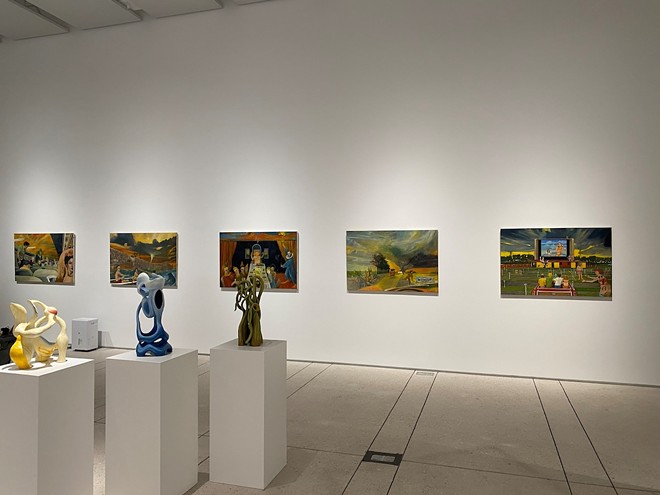
In a sense, Sibbitt had been waiting for 20 years and more for that acceptance email from the Skyway committee.
A professional artist in one form or another throughout most of his life, Sibbitt first trained as a graduate student at UC Berkeley in painting and printmaking. Since then he’s won NEA grants, his work has appeared in Harper’s and in solo and group shows—he’s the real deal, but then money did have to be made.
When he returned to his native Tampa from California, Sibbitt worked in faux finishing, in painting for hire (some of his mural work still graces the low-lit interiors of Bern’s steakhouse), and in occasional logo design. Certainly my favorite logo is Sibbitt’s pizza delivery man, for Sally O’Neal’s Pizza Hotline, which continues to appear on the restaurant’s awning and on its pizza boxes—a job for which Sibbitt was paid in a stack of pizzas, in the barter economy of the Tampa art scene of the 1980s. In the last part of his career, Sibbitt worked as an architectural photographer, often providing the photos for homes that Leslie listed and sold. He went where the money was, and by the time he got tired of all that it was time to retire.
“I was telling him, ‘You know, honey, we’re good, you can retire,’” Leslie remembered. “And I think it was that Christmas when I went to the local art supply store and bought him the best oil paints I could find . . . I just wanted to ignite the fire again, to help him go for it.”
In the early months of retirement, or really semi-retirement—odd photography jobs for old clients continued to come in—Sibbitt answered emails and played a lot of solitaire in a studio hung with his artwork from previous decades. Then the new work started to come, slowly at first, then faster and faster.
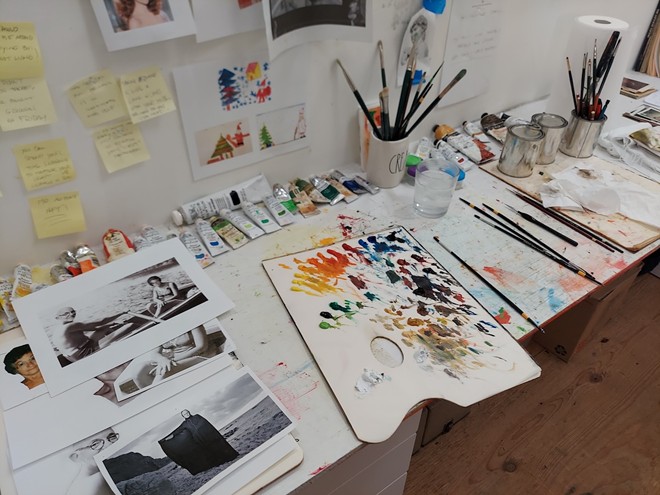
On one of my visits, I had my little son James with me, whom David, always teasing and fond, had started calling Tadpole.
“Here, get in the pool with Tadpole,” he said when we came through the pool gate, past waist-high stands of ferns and the clerodendrum Leslie loves. There was Dyaln on the Bluetooth speaker as David worked at a bit of irrigation repair, evidently. He was kneeling in jeans by a little trench not far from the pool’s edge, shirtless but wearing a white bandana to keep the late spring heat out of his eyes. There was a length of white pipe he must have had plans for.
I got in the pool with Tadpole, enjoying the water and the music. It was late Dylan on the player that day—what was once a keening, impatient voice now murmured about Key West’s fishtail palms, its bougainvillea blooming in the spring (“Winter here is an unknown thing . . .”). I told David I envied him his DIY usefulness—not the nebbish, useless artist I’d become, but someone who knew how to do things with his hands. If my irrigation was on the fritz, I’d have to call in the irrigation people.
“And then they’d look at your South Tampa zip code and triple the quote,” he said, laughing his rasping laugh—a holdover from the throat cancer he survived in his 40s.
“Ah, I’ll come back to this,” he said, getting to his feet and dusting himself off.
When we went into the studio that afternoon, David’s paintings had taken an evolutionary leap forward: not just pencil-sketched versions of the lovably weird photo collages they’d started out as, they now had color and rattling energy, and all the more weirdness and beauty. Everything was bigger, more textured, and in some of the paintings the fine, finishing detail work had already begun.
“I’m sometimes out here,” he told me, “and I’m just dab, dab, dab, dab, dab, for hours. Not the 12-hour days I used to do in my 20s, but hours at a time, and I’m excited as ever. Then I look down and my ankles and feet are all swollen up. I have to stop.”
There was a lot more work to be done, he said, in broad strokes and little ones, but he’d already decided on a title for the series: “A Most Ordinary Apocalypse.”
I nodded at the painting on the easel that day—that turbulent, red-orange sky and underneath it a vision of camp and mythology at once, with David appearing as a Charon-like rower across a River Styx. In the boat seat opposite him, a movingly precise rendering of his late mother. You could compare the small, open face of the woman to the photograph taped to the bottom of the easel.
“I’m older now than she was in that photo,” David said. “That’s what she looked like in her old age.”
Subscribe to Creative Loafing newsletters.
Follow us: Google News | NewsBreak | Reddit | Instagram | Facebook | Twitter

